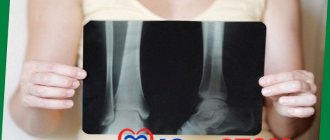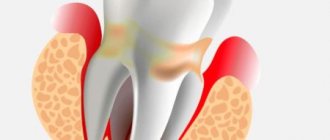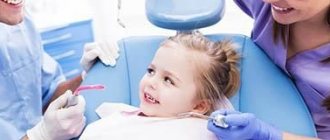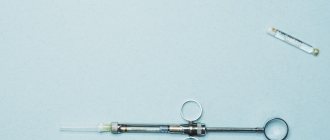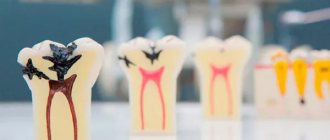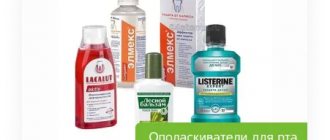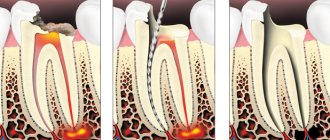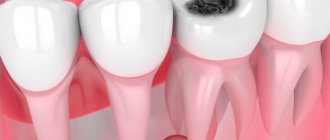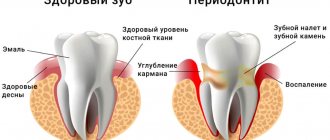What to do if your child has a pink tooth
The tooth consists of both hard and soft tissues. Inside it is soft pulp and nerves. The pulp is made up of a semi-solid material called dentin. Dentin helps form the bulk of the structure and protect the sensory nerves and blood vessels inside. Enamel is a thin coating over dentin that adds another layer of protection. Enamel helps protect dentin and pulp from bacteria. Caries that gets into the enamel and dentin and reaches the pulp can lead to its death. When decay reaches the pulp, it creates a pathway for bacteria to infect the tissue. A healthy pulp will respond to infection the same way as any other part of the body: with inflammation.
Another thing that can cause redness is injury. If you are struck in the jaw by a fall or while playing sports, it can damage blood vessels. The tooth needs blood, so when there is no more blood, it dies. This usually happens slowly over time and does not cause as much pain as when decay reaches the pulp.
During eruption, root resorption occurs. The root is absorbed and begins to dissolve. Once the root is completely resorbed, the baby tooth will fall out - so there will be no visible root. If resorption continues, a pink tint may appear. It may take about 2-3 weeks for the color to change. If the tooth turns red, this is the result of thinning or translucency of the enamel. This looks strange, but is not a cause for alarm. Parents can always consult a dentist if the child is bothered by pain or the shade becomes more intense.
The damage is usually irreversible, but sometimes it can be repaired, especially if it is caused by tooth decay. The dentist will make a diagnosis and recommend treatment.
Black spots
Tooth degradation of this nature can have several causes. One of them is Priestley's plaque , most often caused by disturbances in the microflora of the children's intestines. As a result, both baby and molar teeth are destroyed by bacteria. The disease can only be treated with medication.
Black spots can also be caused by the development of caries. Blackening of teeth is often a consequence of a lack of calcium in the body. For prevention, you need to reduce the amount of sweets you consume.
In addition, you can increase calcium levels by giving your child more milk and using vitamin complexes prescribed by your dentist.
Much less often, but still possible, this pathology can be inherited from parents. Therefore, the child must have personal cutlery (at least a spoon and fork).
How to treat a pink tooth in a child
A pink tooth in a child should not cause panic. It is important to know that this is usually not a serious situation. The problem often occurs in young children and, as a rule, it is harmless - there is no harmful effect on the health of the jaw. A red tooth in a child is a sign of resorption.
If the pink discoloration is persistent, it may indicate a more serious problem and parents should consult a dentist.
The doctor can:
- put a seal;
- remove dentin;
- apply intracanal bleaching.
Treatment depends on various factors and the exact cause of the change in shade.
Disease that causes stains on teeth
A dental disease that manifests itself in the form of multi-colored spots on their surface is called hypoplasia . The disease appears during the gestation period of the future dental patient. It develops in a child if the mother, during pregnancy, had stomach problems, and also had a lack of vitamin D or was exposed to a viral disease.
In such cases, it is necessary to increase the child’s immunity and change his diet. First of all, it is necessary to exclude the possibility of excessive amounts of fluoride entering the body. To do this, you should avoid toothpaste with a high content of it. You need to give your child only purified (bottled or filtered) water, and also give him more vitamins, vegetables and fruits.
With the development of the disease, expressed in the appearance of new spots and an increase in the area of existing ones, remineralization is necessary. The procedure consists of the dentist coating the teeth with a special paste containing substances designed to strengthen the enamel. For hypoplasia detected before the age of eighteen, fluoridation or silvering is also performed.
What to do if an adult’s tooth turns red
As resorption occurs, the pink or red color becomes more noticeable and the structure changes. If you catch the early stage of dying, there is a chance to preserve the external structure. The internal, damaged pulp can be cleaned out and replaced with a hard filling material that will help protect the structural integrity. Preserving as much of the original structure as possible is important for oral health. Gaps in your smile can lead to poor jawbone health, uneven bites, bacterial growth, and cosmetic problems.
If severe damage is observed, removal will likely be the best option. It is recommended to get an implant to maintain the health of your jaw and mouth.
Treatment of stained teeth at the Family Dentist clinic
We have experienced doctors who have been treating caries and non-carious lesions for 15–20 years, and accurately identify the spotted form of hypoplasia. White spots on teeth are similar to early caries and fluorosis. We identify the disease by its shape, color intensity, localization of lesions, smoothness or roughness of the enamel layer. We dry the teeth, examine them under fluorescent lighting, and stain them with methylene solution.
Our pediatric dentists provide attention and care, treat restless and capricious little patients with patience, and make diagnosis and treatment comfortable. Children leave in a good mood and are not afraid to come again.
Dental hypoplasia is irreversible; treatment consists of strengthening the enamel layer and restoring chips, cracks, and color. We select treatment tactics depending on the severity of the disorders and take into account the condition of hard tissues.
We perform remineralizing therapy to strengthen the enamel and prevent caries at the site of the spots. We apply applications or mouth guards with preparations containing phosphorus and calcium. To increase the effectiveness of remineralization, after completing the course we fluoride the teeth to prevent calcium leaching. For hygiene, we recommend prophylactic pastes with fluorides, phosphates, hydroxyapatite crystals, and calcium. In Minsk there are good pastes: Apadent Kids, Children's Pearls, Lacalut Kids, Biorepair Kids.
We excise areas with erosion and install a filling if we are treating brown spots on children’s teeth. Our clinic uses reliable filling materials with fluoride, which are indistinguishable in shine and color from natural enamel. Filling prevents the appearance of cracks, the penetration of microbes, and gives the smile an aesthetic appearance.
We use whitening in older children with slight clouding of the enamel. Whitening methods are effective for isolated chalky stains.
If you notice white or brown spots on your child's teeth, make an appointment with our family dentistry. We will strengthen the enamel, restore damaged areas, and eliminate cosmetic defects.
Why does a filled tooth suddenly turn pink?
If dental treatment was successful, but the healed tooth hurts, this does not indicate any problems, but gives reason to consult a dentist. If the filled tooth turns pink, this may be the result of the fact that the paste contained resorcinol and formaldehyde. But most often the change signals pulpitis, periodontitis, traumatic injury or rupture of a vessel in the pulp.
If a tooth turns red, you should immediately contact your dentist to get a diagnosis. A potential infection should not be left unattended; it is important to ask what treatment options are available and make an informed decision.
Brown spots
Similar manifestations on tooth enamel are also caused by the development of hypoplasia. The disease is generally very common and, according to some estimates, affects up to 40% of children.
The causes of hypoplasia, in contrast to caries, which destroys still growing teeth, are complications during pregnancy or trauma during birth. It can also develop due to poor nutrition, digestive problems and damage to tooth enamel.
For prevention, it is necessary to monitor the condition of the mother’s teeth. You should stop artificial feeding and monitor the child’s nutrition subsequently, as well as regularly visit the dentist.
Causes of the disease
There are a number of reasons leading to tooth root inflammation:
- Deep caries. As you know, at the initial stage, caries is a stain that, without proper treatment, quickly deepens and covers an increasingly larger area of the tooth. Thus, caries passes through layers: enamel, then dentin, and later reaches the inner layer - the pulp. After this, pathological microorganisms can go down the root canal and cause an inflammatory process there. There is also a retrograde type of spread of infection - that is, the spread of pathogens occurs from the roots of the teeth.
- Poor quality dental care. Many people know that regardless of whether you want to remove tartar, put a filling, or just undergo a preventive examination, it is important to contact experienced dentists. Sometimes it happens that poor-quality dental care leads to periodontitis, for example, if the doctor unsuccessfully placed a filling/crown or chose the wrong treatment tactics for pulpitis (inflammation of the nerve of the tooth). There is drug-induced periodontitis, which is formed when chemicals, such as filling materials, enter the periodontal tissue. In the event of an allergic reaction, allergic periodontitis may occur.
- Injuries. Periodontitis often occurs as a result of injuries to the jaw or teeth. Sometimes the development of periodontitis is provoked by an accidental, strong bite of a hard object (for example, a fork).
- Serious inflammatory processes in the body. Sometimes inflammation of the tooth root occurs due to general intoxication of the body, when the infection spreads through the blood or lymph. Often periodontitis also occurs against the background of poisoning of the body.
Caries
Children at an early age are characterized by the so-called “bottle caries”, which develops on several teeth at once due to the habit of falling asleep with a bottle of sweet nutritional mixture. Such food is to the taste not only of children, but also of microorganisms that rapidly multiply in the oral cavity in the presence of a carbohydrate substrate.
The hard dental tissues of toddlers are poorly mineralized, so when the surface layers of enamel are destroyed, they are quickly saturated with food coloring, acquiring a dark and sometimes even black color. Often, with a sufficient content of calcium salts in food, the carious process is stopped, the dentin becomes denser, but the dark color of the eroded surface remains.
With a lack of calcium, the carious process covers a significant area of the tooth surface, leading to its rapid destruction. If it is not possible to close large defects with a filling, then the dentist stops the destructive phenomenon using the silvering method - the enamel is treated with silver nitrate, which, when combined with protein molecules, forms an antimicrobial protective film. The disadvantage of this method is the blackening of the damaged areas, so the method is used on the front teeth only in young children.
Priestley's Raid
Having noticed that the child’s front tooth has darkened, parents take a closer look at other units and may find that dark plaque covers the entire dentition in the area adjacent to the gingival margin.
This is what Priestley's plaque looks like - a bacterial film formed due to dysbacteriosis in combination with lack of dental care. The film stains and becomes darker over time. It is not possible to remove thick plaque on your own, but the dentists at the Shifa clinic have all the necessary equipment to use painless techniques to rid the child’s teeth of staining.
In this case, it would not hurt to consult a gastroenterologist and endocrinologist for early detection of systemic general pathology.
If the filling interferes after treatment
Even in the doctor’s office, after installing the filling, be sure to make sure that the restored tooth is not in the way (move your jaw back and forth, sideways, carefully close your teeth). The filling should not be felt or change the bite. Don’t be shy about talking to your doctor about any discomfort—sometimes the final stage of filling treatment can take even longer than removing cavities and applying filling material.
After treatment, anesthesia wears off within 1.5-2 hours. If a conductor type was used, then after 4-6 hours. Now you are beginning to fully feel the treated tooth, you can fully close your jaws and understand how comfortable you are after filling.
If you experience slight discomfort, it feels like the tooth is a little larger and your jaws aren't closing quite tightly—this is normal. The fact is that now you have been given a new filling in accordance with the bite, that is, with the shape and position of the tooth located on the opposite side. The treated tooth became taller than before - after all, there was caries and the old filling sagged. Therefore, if there is no sharp pain and obvious rejection, be patient for a few days. If the situation normalizes and you get used to it, then there is no reason to see a doctor. If discomfort persists for 1-2 weeks, you should visit your dentist to have the filling corrected.
Varieties
Today, there are two main classifications of tooth root inflammation - classification according to the place of origin of the inflammatory process and according to the form of the disease.
Based on the location of the inflammatory process, apical and marginal periodontitis is distinguished. Apical periodontitis forms in the area near the base of the root and the upper root part, marginal periodontitis begins in the gum area. Apical periodontitis, as a rule, occurs as a result of advanced pulpitis, while marginal periodontitis occurs as a result of trauma.
According to the form of the disease, dentistry distinguishes between acute and chronic periodontitis. The acute form of the disease is characterized by a sharp onset, intense pain (usually when pressing on a tooth and eating hot food), sometimes an increase in body temperature and swelling of the gums at the site of the pathological process and the formation of a fistula. Acute periodontitis can be serous or purulent. In the serous form, the pain is inconsistent; the purulent form is accompanied by a gradual increase in pain and the release of pus from the gums.
If you do not seek dental help at this stage, acute periodontitis can become chronic. In the chronic course of the disease, less pronounced symptoms are observed; as a rule, there is no increase in temperature (however, it can occur during an exacerbation). Mobility of the affected tooth appears, as well as a feeling of heaviness and swelling of the tooth from the inside.
Chronic inflammation of the tooth root occurs in three forms: fibrous, granulating and granulomatous.
The fibrous form of periodontitis can sometimes be detected only with the help of an x-ray or computed tomogram, since this form of chronic inflammation of the tooth root often does not manifest itself symptomatically. Elderly people often experience this form of periodontitis. With this form of the disease, the tissue around the tooth becomes pale pink, and the tooth itself may darken.
The granulating form is diagnosed more often than others. With this form, a channel forms in the gum through which pus comes out. Granulation tissue develops, which grows and can have a negative effect on the bone.
In the granulomatous form of chronic periodontitis, sacs filled with pus form on the gums. Granulomas appear at the apex of the tooth root, which separate the affected part of the tooth from the healthy part.
Ignoring chronic periodontitis can lead to a weakening of the body's immune system, resulting in a constant, low-grade inflammatory process.
Is it painful to treat pulpitis?
Inflammation of the pulp is a disease characterized by pronounced, extremely acute symptoms, mainly in terms of pain. Almost any manipulation with a damaged element of the oral cavity causes severe discomfort to patients in medical clinics. However, such a problem can be resolved quite simply - a good dentist will easily select a high-quality, suitable anesthetic agent. That is why the process of surgical intervention itself, as a rule, takes place without third-party excesses. Much more unpleasant sensations await people who refuse to visit a doctor in a timely manner.
How long should you not eat after having a filling installed?
If a filling made of chemical composites is installed, then you should refrain from eating and drinking for 2 hours. This is due to the fact that the material requires a certain time for final shrinkage and hardening.
If a “light” composite filling is installed, you can drink immediately, but you should abstain from food for 1.5-2 hours. But the reason is not in the material (it hardens a few seconds after application), but in anesthesia - with reduced sensitivity of the mucous membranes during eating, you can injure the tongue and mucous membranes of the cheeks on the inside.
During the day after the filling is installed, you should only eat warm foods - excessively hot or cold foods can lead to changes in the shape of the filling. It is necessary to chew food on the opposite side for the first day - this will allow the material to fully “adhere” to the tissues and take the desired shape, without the risk of damage.
How to maintain your treatment guarantee
As a rule, therapeutic treatment, that is, dental filling, is guaranteed from 6 months to 2 years - depending on the volume of work and the complexity of the situation. To maintain the guarantee, the patient must strictly follow all recommendations: do not overload the tooth, do not use it for other purposes (for example, open beer bottles), and also regularly see the doctor in accordance with the individual schedule of medical examinations. Unfortunately, many patients forget about this, and it is the last point that is the key to maintaining the guarantee for treatment.
You need to visit a doctor 1-2 times a year. During a preventive examination, the dentist will be able to make sure that the filling is in good condition and that caries does not develop again underneath it.
Other treatments
In 2022, there are additional ways for doctors to save people from troubles associated with pulp inflammation:
- laser therapy;
- complex of physiotherapeutic processes.
Both mentioned operations, in principle, can also answer the question of how to cure pulpitis without removing the nerve. True, they can only be used in the early stages, when the pathology has not yet had time to develop and acquire serious symptoms. In addition, to use such funds, a person will need to go to a truly modern and advanced clinic with an experienced medical team. For example, a set of works related to the use of a laser is carried out exclusively in the presence of high-quality, proven equipment. Such installations, of course, are present in dental departments.
Caries of primary teeth and its ENT complications
Sometimes parents unsuccessfully try to understand why their child often suffers from colds, complains of ear pain, and suffers from a chronic runny nose. And few people realize that the reason for weakened immunity lies in the baby’s untreated teeth. How can this be? It turns out that it’s all about pathogens! Caries develops under the influence of pathogenic bacteria, which can also cause diseases of the gastrointestinal tract and respiratory system of the child. Therefore, timely treatment of caries is important, including for maintaining the normal functioning of other organs of the baby.
Is it necessary to follow a diet after caries treatment?
From the diet as a whole after caries treatment (especially if a large filling is installed and your own tooth has very thin walls), it is recommended to remove too hard foods - toffees, chewing gum, grilled fruit, nuts, etc. Or chew them with teeth located on the opposite side (if they do not have fillings).
Minimize the amount of consumed foods and drinks that contain coloring pigments (tea, coffee, beets) - under their influence, the filling material may slightly change its shade. This rule is especially relevant when restoring front teeth.
Do baby teeth hurt due to caries?
Painful sensations when the surface of the teeth comes into contact with sweet, sour or salty food irritants is one of the first signs of incipient caries on baby teeth. Further, the discomfort in the affected teeth will only intensify, and when caries affects the pulp, the teeth begin to hurt like adults. In addition to acute pain, this stage of the disease is characterized by a high risk of premature removal of a baby tooth.
Publisher: Expert magazine about dentistry Startsmile.ru

